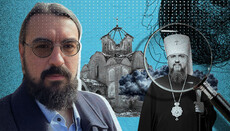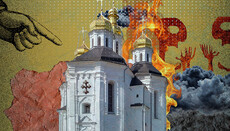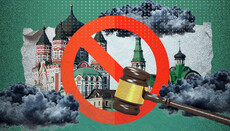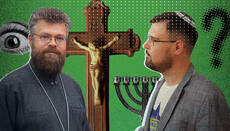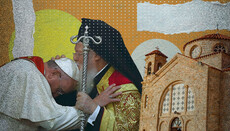1500 Problems for the OCU
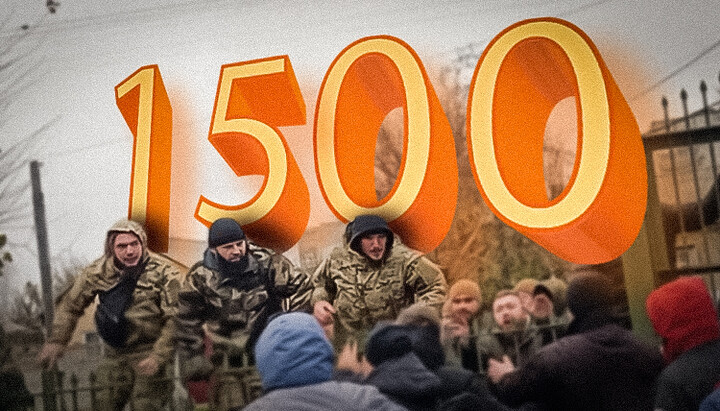
The Statement of the Holy Synod of the UOC dated April 10, 2024, says there are 1500 seized temples, unlawfully transferred to the OCU. What is really going on?
Such a large number was officially announced for the first time. Previously, there were voiced hundreds of seized temples without specifying the number of these hundreds.
It is noteworthy that the number announced by the Synod of the UOC was immediately picked up by the OCU. For example, the former Metropolitan of the Ukrainian Orthodox Church, now a "hierarch" of the OCU, Alexander Drabinko, reported in a recent interview with "Polskie Radio" that "more than one and a half thousand parishes have already joined the Local Orthodox Church of Ukraine." According to him, the "intensity of joining" the OCU is "very high".
Why did Drabinko snatch at this figure? It's clear. The creators of the OCU project both in the Phanar and in Ukraine need to show that despite all the difficulties, their project has succeeded, and soon there will be no one left in Ukraine except the OCU. This means that despite having to sacrifice the canons of the Church and condemn millions of believers of the UOC to suffering from the authorities and radicals, they did everything right. The end justifies the means, and winners are not judged. Let's rush to disappoint them: in reality, everything is quite different.
Obvious inconsistencies
First, let's compare two points. Let's assume that the announced figure of 1500 parishes transferred to the OCU means that this organization has indeed gained 1500 new religious communities. But in that case, the "clergy" of the OCU should have increased by the same 1500 ministers. However, representatives of the OCU constantly complain about a catastrophic lack of "priests". Here's a recent complaint: the head of the Poltava Diocese of the OCU, Fedor Bubniuk, reported that his structure lacks chaplains and that they have to recruit them from the military themselves, "who are believers, who feel this is their calling." A few years ago, "Metropolitan" Daniil of the OCU Chernivtsi and Bukovyna urged to "treat with understanding the temporary shortage of clergy" in parishes that "have come out from under the Moscow yoke" and begged men to "be ordained" even without education and other requirements. "We implore – look for men in the villages who are worthy to serve the Lord God in the Holy Church. Men who can take on the burden of priesthood – accept it for the sake of your children's future, our Church, and the state. We will help you acquire the knowledge necessary for serving in the Church to God and people," he wrote on his social media pages. But, as we can see, the situation in the OCU remains unchanged, and there is still a shortage of ministers.
Even comparing these two facts makes you wonder: did 1500 communities really leave the UOC, and did they come to the OCU? And if we get acquainted with what exactly is happening in each of these 1500 cases, then we will see an amazing picture: the temple is taken away, but the community remains in the UOC and even strengthens.
Classification of seizures
If we generalize all cases of transitions/transfers/seizures of communities to the OCU, we can come up with approximately the following classification.
I Category: Voluntary non-confrontational transition.
Such cases are very rare, there are only a few dozen of them, but they still occur, and it would be wrong to remain silent about them. This is indeed a manifestation of the free will of parishioners who, for one reason or another, want to join the "national church" (we put this phrase in quotation marks, as the Church of Christ cannot be national by definition). They hold meetings, vote, and move under the jurisdiction of the OCU. Usually, in these cases, the priests also participate in the transition. These communities do not face any opposition from the UOC, no one comes and prevents such a step of theirs. The clergy are, of course, banned from priesthood for backsliding into schism, which they disregard. The few parishioners, if any, who do not want to leave the UOC, simply find another church, another religious community, even if they have to overcome significant distances to do so.
Why is this type of transition encountered extremely rarely today? Simply because if both the parish and the majority of the actual parishioners and the priest wanted to be in the "national church", they would have done so long ago. In 2019-2020, immediately after the creation of the OCU or even earlier, by joining the UOC-KP created by Filaret Denisenko. However, even in those times, there were not many such transitions.
II Category: Majority is for the OCU; UOC priest and minority are against.
In this case, everything happens as in the previous category, with the only difference being that the minority still tries to resist the transition and convince others that it is not a transition from one jurisdiction to another but a full-fledged betrayal of the Church. Typically, such attempts are unsuccessful, and the minority, together with the priest, has to find another place for worship. This type of transition is already illegal because, according to the charter of the religious community, only the priest can convene a community meeting. But in this case, both the priest and part of his community are forced under the pressure of the majority to leave their temple.
It should be emphasized that when talking about the "majority" or "minority", we mean actual parishioners who regularly attend the church and participate in worship services. Types of transitions whereby the "majority" consists of those who come to the church only a few times a year or do not attend at all are considered below.
III Category: Active minority is in favor of the OCU.
Despite the majority of real parishioners along with the priest being against the transition, the active minority does not want to accept this and considers it their duty to transfer the temple to the "national church". In this case, they have a variety of resources at their disposal, from administrative support to groups of radicals ready to resort to physical violence.
Typically, the initiative to transition the church to the OCU does not come from the minority of believers but from local authorities or residents of the locality who have little or no relation to the Church. However, such initiatives find support from two or three or slightly more parishioners, and they begin to take action. These may even be former parishioners who, at some point, became embittered and left the community, but in the matter of transitions and takeovers, having traitors from among the believers greatly facilitates the process. It's all similar to the Gospel; the Pharisees could have seized Jesus Christ independently, but the participation of Judas, one of the twelve apostles, greatly helped them.
The typical scheme of transitions/takeovers looks like this: with the support of local authorities, a meeting of the territorial community or some of its parts is organized, where the majority votes for the community's transition to the OCU. The opinion of the religious community itself is not taken into account; no arguments or references to the canons of the Church or the laws of Ukraine are accepted. The fact that the UOC is free and independent in management, that it has officially declared support for the sovereignty and territorial integrity of Ukraine, that it blesses believers to defend our country, and that it provides material and financial assistance to the Armed Forces of Ukraine, is of no interest to anyone. The assembly votes to transition to the OCU. This is a direct violation of Ukrainian law "On Freedom of Conscience and Religious Organizations", which stipulates that only the religious community itself, i.e., the actual parishioners who regularly participate in worship and sacraments, can change the jurisdiction of the religious community.
Then the voting results are formalized and transferred to the state registration authorities, which, also ignoring the law, re-register the community in favor of the OCU. But often before this process is completed, which is delayed in many cases due to the fact that the actual UOC community tries to defend its rights in court, local authorities and active supporters of the transition to the OCU undertake a forcible seizure of the temple. They recruit strong young men for this, come in crowds to the temple, cut off locks, resort to violence toward UOC believers, and thus expel the church community from the temple.
The degree of conflict and violence can vary from cases where the UOC community peacefully leaves the temple to harsh takeovers with the use of violence.
IV Category: Lawlessness
This occurs when the entire community is against the transition, conducts a real assembly, unanimously votes to remain faithful to the UOC and its Primate Metropolitan Onuphry, submits relevant documents to local authorities, but is still subjected to the scheme described in the previous category. No protests, appeals to the law, appeals to courts, or law enforcement agencies help. Often such takeovers occur in a very harsh form with beatings of believers and sacrilegious acts against the temple. For example, in the Kazan Church in the village of Ladyzhin, Vinnytsia region, supporters of the OCU even broke down the church doors using a bulldozer. The video surveillance footage taken on the night of January 9, 2024, captured the storming of this church.
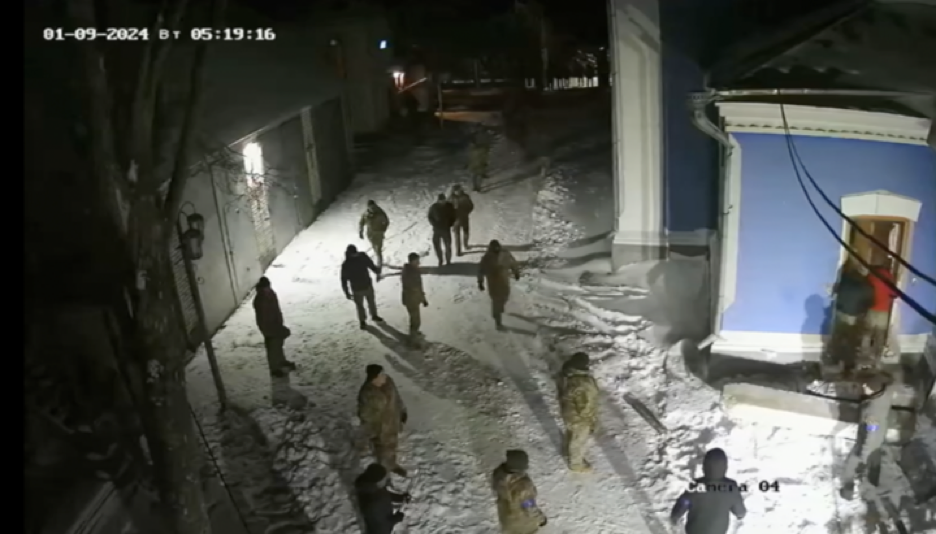
OCU militants storm the church in honor of the Kazan icon of the Virgin Mary in Ladyzhyn. Photo: screenshot of a surveillance video
The footage shows how the attackers, using a forklift, break down the door leading to the sacristy and burst inside. Within seconds, they start throwing people who were inside the church – parishioners and the priest – onto the street. They drag them down the stairs, throw them to the ground, and then drive them beyond the church territory, pushing, striking, and twisting their arms. The face of Archpriest Yevhen Vorobyov was smashed to the blood.
Recently, attackers have not even bothered to hold fake meetings. On April 16, 2024, the Cherkasy Diocese of the UOC reported: "As has become customary in recent months, for the raider seizure of another Orthodox church by the OCU, they even stopped, as before, holding fake meetings of territorial communities, which were then passed off as meetings of 'religious communities'. Everything happened much simpler: in mid-March 2024, the 'cleric of the OCU' Mykola Yevhenyev and the head of the local community Bohdan Shkarbuta held a meeting of the religious community 'on changing allegiance to the OCU' somewhere at his home, single-handedly, even without the knowledge of the territorial community of the village of Moshny. Without authority, statute, or the seal of the parish, Mykolai Yevhenyev submitted protocols of his home meeting to the state registration authorities. And on April 4, 2024, state registrar Yevhen Shtryk made changes to the EDRPOU for the Transfiguration of the Savior religious community, illegally changing the name, replacing the leader, and deleting the founder of the religious community. 'Now all that remains for the militants is to drive away the legal owners of the temple with sticks and grinders, beat and throw the parishioners out onto the street, and hand over the historical Vorontsov church-beauty for use by the OCU. Thus, we will have another 'voluntary transition of the religious community!'" wrote the diocese.
The Future fate of UOC communities
The last two categories of our hypothetical classification are the most common, accounting for about 80-90% of all cases from the mentioned figure of 1500. However, in all these cases, the community loses its church building, loses its registration as a UOC community, but remains as an actual community. Those who rejoice that such a community has had its church taken away do not understand one fundamental Christian truth: the Church is not buildings, and certainly not documents of state registration. The Church is the Body of Christ, people united by the Holy Spirit. "For as the body is one and has many members, but all the members of that one body, being many, are one body, so also is Christ" (1 Corinthians 12:12), "Now you are the body of Christ, and members individually" (1 Corinthians 12:27).
And so, this community, alive and real, does not go anywhere. It remains together with its priest in the Ukrainian Orthodox Church. They find some other place for worship. These can be abandoned shops, warehouses, trailers, old cottages, and so on. Believers repair them, adapt them for worship, decorate them with icons. Sometimes the community manages to raise funds for the construction of a new church. Of course, not as large as the one they lost, not with such a prominent church architecture, but nevertheless, the community continues to live on, pray, perform sacraments, and commune with Christ through the Divine Liturgy. In this regard, nothing changes.
As an example, let's mention the story of the Peter and Paul Church in Bucha near Kyiv. On December 18, 2023, at 5 a.m., raiders from the OCU broke down the door of the Peter and Paul Church in Bucha and burst inside. On the same day, the city authorities reported that the first "liturgy" of the OCU took place in the church. The UOC community was forced to leave the church and began to hold services in a school assembly hall, which was repurposed by the believers.
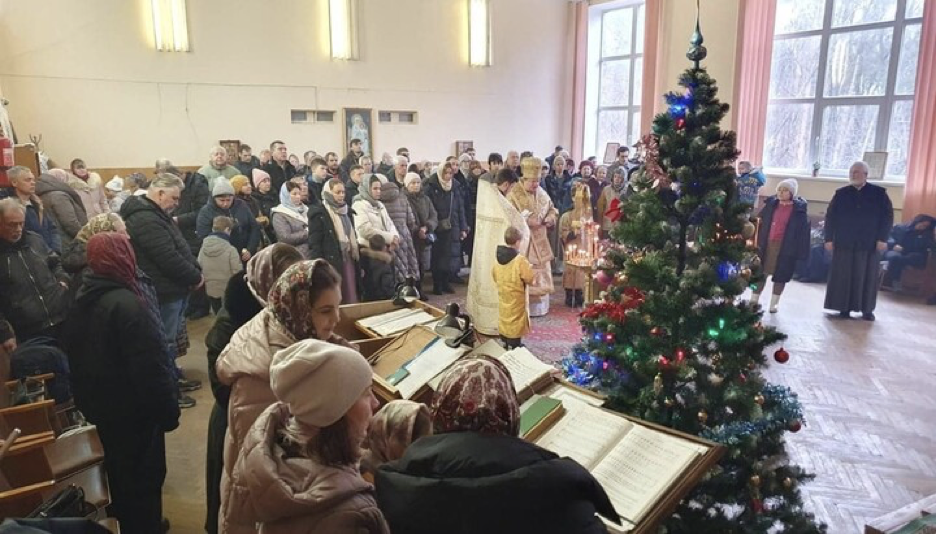
Divine Liturgy in the assembly hall in Bucha. Photo: Archbishop Iona's Facebook page
In this photo, the community of the seized church is praying together with Bishop Arkadiy of Hostomel. Judging by the Christmas tree, only a few weeks have passed since the church was seized. This means that the UOC community not only did not cease to exist but also did not interrupt its liturgical life. Meanwhile, the church taken from the UOC believers stands empty.
Communicating with such communities and their priests reveals an interesting pattern. People who have gone through trials, hatred, and misunderstanding from others and still remained faithful to Christ and His Church become stronger in their faith and more conscious Christians. This is understandable and explainable. But there is also another joyful trend. Often, after losing the church and moving to another place for worship, more people come to the services than before all these events. It's amazing: the Church is persecuted, yet it still grows. People who were previously indifferent to the Church, seeing how believers endure trials and remain faithful to the Church, begin to wonder: why is that? What treasure is in the Church that one can endure expulsion, slander, violence, and everything else for it? And such people join the persecuted community consciously, not succumbing to any fashion or public opinion.
1500 seized churches do not mean minus 1500 communities. These are the same living communities within the UOC, only more united, more conscious, and often more numerous.
There is another aspect that is currently unnoticed but will increasingly manifest itself over time. It's about money. If before the seizure of the church, the community spent significant funds on its maintenance and beautification, then after that, this expense item disappears. Of course, not in every case does the community's budget remain at the same level, but where it more or less does, other areas for spending financial resources emerge. Figuratively speaking, the money that was invested in the church building begins to be invested in people, in the broadest sense of the word. This includes helping needy community members, supporting large families, paying for surgeries, and so on. All this makes the community more similar to those early Christian communities we read about in the Acts of the Apostles and in the history of the ancient Church. In turn, this active manifestation of the God-commanded love further attracts people who see true disciples of Christ in today's Christians.
All of this, of course, should not be perceived as if the seizure of churches is a blessing for the UOC. Far from it. All of this is very difficult, and many believers languish under the weight of today's trials. But God often admonishes people through sorrows. Through trials, He directs them towards perfection and growth in spiritual life. Let's remember the story from the Book of Acts. When the first persecution of the Jerusalem apostolic Christian community occurred, when the first martyr, Archdeacon Stephen, was killed, it was evil. But when the apostles left Jerusalem and dispersed to other places, they brought the Good News to other cities and peoples. And that was good.
What does the OCU get in return? They get the church building, which needs to be maintained, heated, repaired, and so on. They need to conduct services for which there are neither priests nor choirs. They get formal registration in the state registry, behind which there is no real community life. All those who falsified documents, cynically lied, slandered, plotted intrigues, and beat believers cannot simultaneously cherish liturgy, prayer, and church sacraments. Their "religious" abilities are demonstrated only once during the seizure of the church, and the rest does not interest them. As a result, those people who actively advocated for the transition to the OCU enter it immediately after the seizure, and no one sees them there anymore. The OCU lacks "priests", and the new, usually very small community finds itself in a situation where the "father" rarely visits, hardly serves liturgies, limiting himself to brief molebens. Accordingly, the motivation to attend church decreases, and very soon, such a church is left empty and no longer needed.
So, one is tempted to ask a representative of the OCU, as well as their curators from the Patriarchate of Constantinople: why do you need empty churches? What will you do with them? The answer can be found, for example, in the recent news: Roman Catholic Archbishop William Lori of Baltimore, Maryland, USA, due to the reduction in the number of parishioners (by 100 times over the last 40 years), decided to reduce the number of his parishes from 61 to 21 and the number of churches from 59 to 26. This is exactly what awaits the OCU, and no government support will help here.
Therefore, answering the question posed in the title of this article, let's say: 1500 seized churches are neither many nor few, it is a figure that shows how many church buildings now need to be additionally maintained by the OCU.
Meanwhile, the number of UOC believers not only does not decrease but even grows, as does the number of monastic tonsures, ordinations, and consecrations of new altars where the Sacrament of the Eucharist is performed. This means that the words of Christ: "I will build My Church, and the gates of Hades shall not prevail against it..." (Matthew 16:18) are once again confirmed in the history of the Church.
